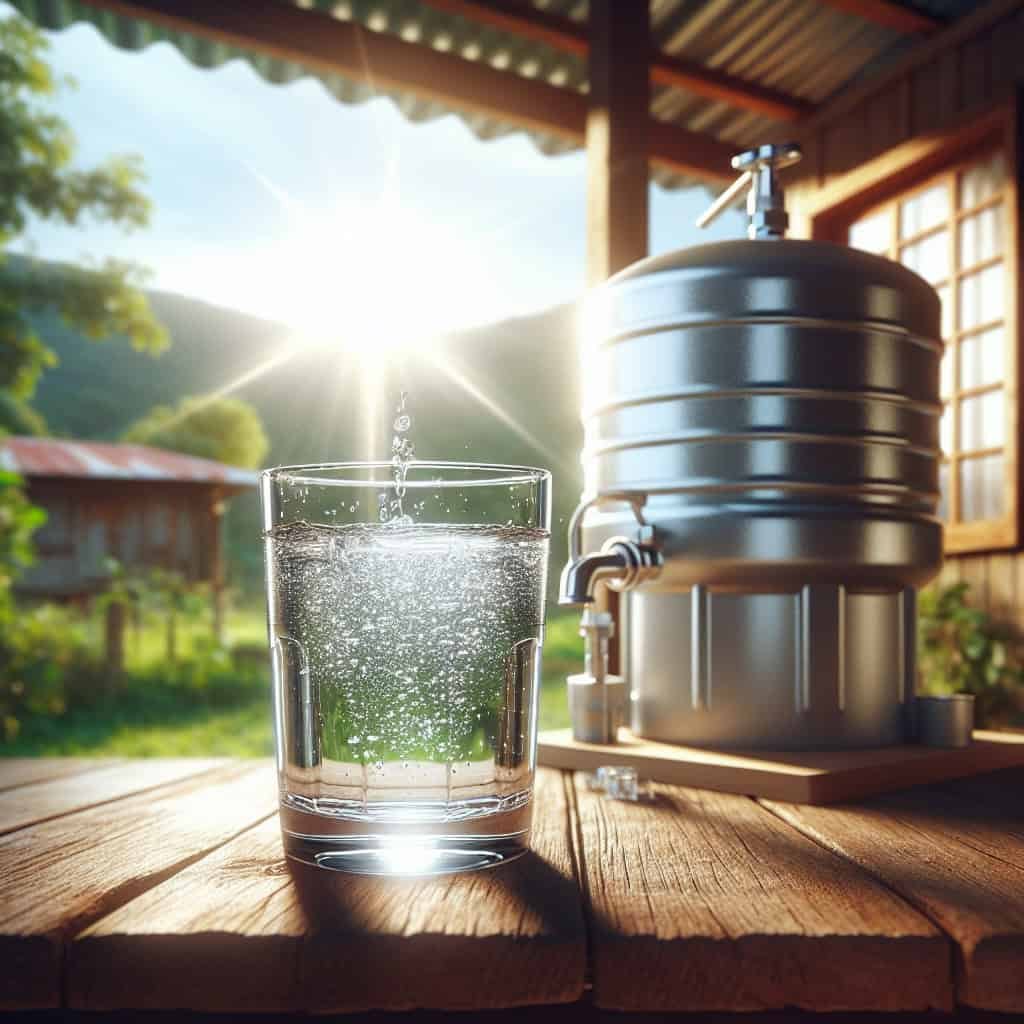In this article, we will explore the essential steps you can take to guarantee the safety of your well water in areas where there are maintenance schedules for well water pressure tanks. Ensuring the well water’s safety is crucial to safeguard the health and well-being of you and your loved ones. We will provide you with practical tips and advice on maintaining the integrity of your well water system, understanding the importance of regular maintenance, and taking proactive measures to prevent any potential risks. With our helpful insights, you can feel confident in protecting your well water supply and enjoying clean, safe water all year round.
Understanding Well Water Pressure Tanks
What is a well water pressure tank?
A well water pressure tank, also known as a pressure vessel, is an essential component of a well water system. It plays a crucial role in maintaining and controlling the pressure of the water that is drawn from your well. The tank consists of two chambers: one for storing water and another for compressed air. It works by using the compressed air to create pressure in the water chamber, allowing water to be pumped out when needed.
Importance of well water pressure tanks
Well water pressure tanks are vital for ensuring a steady and consistent flow of water in your home. They help to regulate the pressure of the water, preventing any spikes or drops that could cause damage to your plumbing system. By providing a buffer between the well pump and the water supply, pressure tanks also help to extend the lifespan of the pump, reducing the need for frequent repairs or replacements. Additionally, pressure tanks allow for a more efficient distribution of water throughout your home, ensuring that you always have a sufficient supply for all your needs.
Maintenance of Well Water Pressure Tanks
Inspection and cleaning
Regular inspection and cleaning of your well water pressure tank are essential to ensure its proper functioning and longevity. You should inspect the tank for any signs of corrosion, leaks, or damage to the valves, fittings, and the tank itself. Clean the tank by flushing out any sediment or debris that may have accumulated over time. This can be done by opening the tank’s drain valve and allowing water to flow out until it runs clear.
Checking for leaks
It is important to regularly check for any leaks in your well water pressure tank. Inspect all the connections, valves, and fittings for any signs of water leakage. If you notice any leaks, it is crucial to address them immediately to prevent further damage to the tank or your plumbing system. Tighten loose fittings or replace faulty components as needed.
Monitoring pressure levels
Monitoring the pressure levels in your well water pressure tank is vital to ensure its proper operation. Use a pressure gauge to check the tank’s pressure regularly. The ideal pressure range for most well water systems is typically between 40 and 60 pounds per square inch (psi). If the pressure is consistently outside this range, it may indicate a problem with either the tank or the well pump. Consult a professional if you notice any significant fluctuations or abnormal pressure levels.

Potential Risks in Well Water
Contamination from surface water
One of the potential risks associated with well water is the contamination from surface water sources. If your well is not properly sealed or located in an area prone to flooding, there is a higher chance of contaminants such as pesticides, fertilizers, or bacteria entering your well water. It is essential to regularly inspect the well cap and seal any potential entry points to prevent surface water contamination.
Presence of bacteria and pathogens
Another risk in well water is the presence of bacteria and pathogens. Well water is susceptible to microbial contamination, especially if the well is not adequately constructed or maintained. Common bacteria such as E. coli or coliforms can pose significant health risks if ingested. Regular testing and disinfection are crucial to ensure the safety of your well water.
Chemical contaminants
Chemical contaminants can also be present in well water, depending on the local geological composition and nearby human activities. These contaminants may include heavy metals, pesticides, nitrates, or volatile organic compounds (VOCs). Testing your well water regularly and utilizing appropriate filtration methods can help detect and remove these chemical contaminants, maintaining the safety of your water supply.
Ensuring Well Water Safety
Regular testing and analysis
To ensure the safety of your well water, regular testing and analysis are essential. Test your well water at least once a year for bacteria, nitrates, and other common contaminants. It is also recommended to test for additional parameters such as pH, alkalinity, hardness, and any specific local concerns. Analyzing the test results will help you identify any potential issues and determine the necessary steps to maintain the safety of your well water.
Proper disinfection methods
If your well water tests positive for bacteria or pathogens, disinfection is necessary to eliminate these harmful microorganisms. The most common disinfection method for well water is chlorination. By adding a specific amount of chlorine to your well, you can effectively kill bacteria and ensure the safety of your water supply. However, it is crucial to follow proper guidelines and consult a professional to determine the appropriate concentration and contact time.
Installing additional filtration systems
Depending on the specific contaminants present in your well water, installing additional filtration systems may be necessary. Activated carbon filters are commonly used to remove chemical contaminants and unpleasant odors and tastes. Reverse osmosis systems can effectively remove a wide range of contaminants, including bacteria, viruses, and dissolved minerals. Ultraviolet (UV) filters can be used to disinfect well water by utilizing UV light to kill bacteria and pathogens. Consulting a water treatment specialist will help determine the most suitable filtration system for your well water.

Understanding Well Water Testing
Frequency of well water testing
Regular well water testing is crucial to ensure the ongoing safety and quality of your water supply. It is generally recommended to test your well water at least once a year. However, certain circumstances may require more frequent testing, such as if your well is located near potential contamination sources or if you notice any changes in the appearance, taste, or odor of your water. Consult local health authorities or water testing labs for specific guidelines based on your location and circumstances.
Testing parameters to consider
When conducting well water testing, certain parameters should be considered to have a comprehensive analysis of your water quality. Common parameters include bacteria (such as E. coli or coliforms), nitrate, pH, alkalinity, hardness, total dissolved solids (TDS), and specific local concerns like heavy metals or chemical contaminants. Testing for these parameters will provide valuable information regarding the quality and safety of your well water.
Interpreting test results
Interpreting well water test results can sometimes be complex, especially if you are unfamiliar with the various parameters and their acceptable levels. Most water testing labs provide detailed reports that indicate the test results alongside the relevant guidelines and limits set by regulatory agencies. It is important to understand these results and consult with professionals if any parameters exceed the recommended limits. They can provide guidance on the necessary actions to address any concerns and maintain the safety of your well water.
Disinfection Methods for Well Water
Chlorination
Chlorination is commonly used as a disinfection method for well water. By adding chlorine to your well water, you can effectively kill bacteria and other pathogens. The amount of chlorine required will depend on the specific contamination levels detected in your water and the volume of your well. The chlorine should be thoroughly mixed by running the water through all faucets and fixtures. It is important to follow proper guidelines and consult with professionals to ensure the correct concentration and contact time for effective disinfection.
UV disinfection
UV disinfection is another effective method for treating well water. UV light is used to destroy the DNA of bacteria, viruses, and other microorganisms, rendering them inactive and unable to reproduce. UV disinfection systems are typically installed at the point of entry, treating all the water that enters your home. This method does not require the use of chemicals and is relatively simple to maintain. However, it is crucial to ensure that the UV system is properly sized and calibrated for your specific flow rate and water quality requirements.
Chemical sanitizers
In some cases, chemical sanitizers other than chlorine may be used for disinfecting well water. These sanitizers can include hydrogen peroxide, chlorine dioxide, or ozone. The selection of the appropriate chemical sanitizer will depend on various factors, such as specific water quality issues, required disinfection levels, and personal preferences. Consulting with professionals or water treatment specialists will help determine the most suitable chemical sanitizer and its proper application for your well water disinfection.

Additional Filtration Systems for Well Water
Activated carbon filters
Activated carbon filters are commonly used as an additional filtration system for well water. These filters work by adsorbing and removing contaminants, including organic compounds, chlorine, and volatile organic compounds (VOCs). Activated carbon filters can effectively improve the taste and odor of your well water, providing you with a cleaner and more enjoyable drinking experience. They are generally installed at the point of use or at the point of entry to treat all the water entering your home.
Reverse osmosis systems
Reverse osmosis (RO) systems are highly efficient in removing a wide range of contaminants from well water. These systems utilize a semi-permeable membrane to filter out dissolved impurities, including bacteria, viruses, heavy metals, and chemicals. Reverse osmosis systems can provide you with purified and safe drinking water, ensuring the highest level of water quality. They are typically installed at the point of use, such as under the kitchen sink, and require regular maintenance, including replacing filters and sanitizing the system.
Ultraviolet (UV) filters
Ultraviolet (UV) filters are another effective additional filtration system for well water. UV filters use UV light to disinfect well water by inactivating bacteria, viruses, and other microorganisms. By exposing the water to UV light as it flows through the filter, harmful pathogens are eliminated, ensuring the safety of your water supply. UV filters are typically installed at the point of entry, treating all the water that enters your home. They require periodic lamp replacement to maintain their effectiveness.
Well Water Safety Guidelines
Avoiding contamination sources
To ensure the safety of your well water, it is important to take measures to avoid potential contamination sources. These sources can include septic tanks, livestock areas, fertilizers, pesticides, and other chemicals. Properly locating and constructing your well, as well as creating a buffer area around it, can help minimize the risk of contamination. Regularly inspecting and maintaining your well, as well as practicing proper waste management, will further reduce the chances of pollutants entering your water supply.
Proper well construction and maintenance
Proper well construction and maintenance are key to ensuring the safety of your well water. Well construction should follow local regulations and guidelines to prevent contaminants from entering the well. This includes correctly sealing the well casing and ensuring the well cap is secure and in good condition. Regular maintenance, such as inspecting the well components, checking for leaks, and cleaning the well, is essential to address any potential issues promptly and maintain the quality of your well water.
Educating well owners
Education plays a vital role in ensuring the well water safety of not only your own well but also the community. Well owners should be aware of proper well construction and maintenance practices, as well as the potential risks associated with well water. Local health authorities, water treatment professionals, and community organizations can provide resources and educational materials to help well owners understand and implement appropriate measures to safeguard their well water.

Importance of Regular Maintenance
Preventing equipment failure
Regular maintenance of your well water pressure tank can help prevent equipment failure. By inspecting and maintaining the tank, you can identify and address any potential issues before they escalate into significant problems. This includes checking for leaks, corrosion, and damage to valves and fittings, as well as cleaning the tank to remove sediment or debris buildup. Taking proactive measures through regular maintenance will help ensure the proper functioning of your pressure tank and reduce the risk of unexpected breakdowns.
Extending the lifespan of pressure tanks
Proper maintenance of well water pressure tanks can contribute to extending their lifespan. Regular cleaning and inspection prevent sediment buildup and corrosion, which can lead to premature deterioration of the tank. Addressing any leaks or damage promptly helps to maintain the structural integrity of the tank, allowing it to perform optimally for a longer period. By investing time and effort into regular maintenance, you can maximize the lifespan of your pressure tank, minimizing the need for costly replacements.
Ensuring consistent water quality
Regular maintenance of your well water pressure tank helps ensure consistent water quality. By monitoring pressure levels and addressing any abnormalities promptly, you can prevent fluctuations in water pressure that may impact the performance of your plumbing system. Maintaining the proper pressure range in your pressure tank also helps prevent air or sediment from entering your water supply, ensuring that the water distributed throughout your home remains clean and free from contaminants. Consistent water quality contributes to a healthier and more enjoyable water experience for you and your family.
Seeking Professional Assistance
Hiring certified well professionals
When it comes to well water safety and maintenance, seeking professional assistance is highly recommended. Certified well professionals have the knowledge, skills, and experience necessary to handle various aspects of well water systems. They can conduct thorough inspections, perform maintenance tasks, test water quality, and provide expert advice on the proper functioning and safety of your well. Hiring certified professionals ensures that your well is in capable hands and reduces the risk of potential errors or oversights.
Choosing reputable water testing labs
For accurate and reliable well water testing, it is important to choose reputable water testing labs. Look for labs that are certified and accredited by recognized organizations, as this indicates their adherence to strict quality standards. Reputable labs will provide detailed reports with clear explanations of the test results, making it easier for you to understand and interpret the data. They can also offer guidance and recommendations based on your specific water quality concerns, helping you make informed decisions regarding the safety and treatment of your well water.
Consulting with health authorities
When in doubt or if you have specific concerns about your well water safety, consulting with local health authorities is highly recommended. They can provide valuable information regarding well water regulations, guidelines, and recommendations specific to your area. Health authorities can also guide you on well water testing requirements, the interpretation of test results, and the appropriate steps to address any issues or potential risks. Their expertise and support ensure that you are well-informed and equipped to maintain the safety of your well water.
In conclusion, understanding well water pressure tanks and implementing proper maintenance practices are essential for ensuring the safety and quality of your well water. Regular inspection, cleaning, and checking for leaks contribute to the optimal functioning and extended lifespan of pressure tanks. Being aware of potential risks, such as contamination from surface water, bacteria and pathogens, and chemical contaminants, allows you to take appropriate measures to safeguard your water supply. Regular testing, proper disinfection methods, and installing additional filtration systems contribute to maintaining well water safety. Following well water safety guidelines, prioritizing regular maintenance, and seeking professional assistance when needed are crucial for minimizing risks and ensuring the well-being of you and your family.


